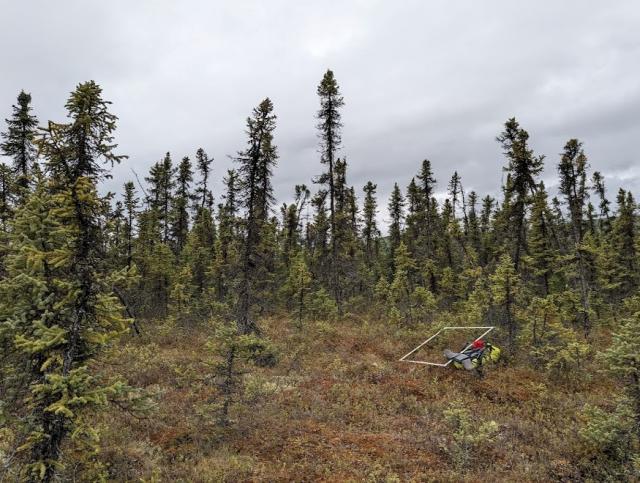Home > International Partnerships > Collaborative Research > Mechanism of maintaining plant biodiversity in boreal forests in terms of seasonal soil thaw and leaf phenology
Update:May 1, 2025
Main content starts here.
Mechanism of maintaining plant biodiversity in boreal forests in terms of seasonal soil thaw and leaf phenology
1. Partners
International Arctic Research Center, University of Alaska Fairbanks, United States of America
2. Research Period
FY2024~2026 Grant-in-Aid for Scientific Research (KAKENHI)
3. Lead Researcher
AMADA, Gaku
4. Background
Circumpolar regions are warming two-four times as fast as the globe, and influences of permafrost degradation on boreal forest ecosystems have been concerned. In North America, boreal forests underlain by permafrost consist of an evergreen conifer crown tree species, black spruce (Picea mariana), which has the longest leaf lifespan (up to 30 years) (Figure 1). However, in the understory of such permafrost forests, a diverse range of plants with varying leaf lifespans are observed in the same location, including evergreen shrubs (1-2 years), deciduous shrubs (4-5 months), and perennial herbs (1-2 months) (Figure 2). Yet, it remains unclear how such plant diversity is maintained in the harsh permafrost environments. Understanding the mechanism for maintaining plant diversity on permafrost is crucial for predicting the impact of warming in the circumpolar regions.
5. Research Goal
This study aims to elucidate the mechanism of plant diversity with varying leaf lifespans in a black-spruce forest of Interior Alaska by examining resource use efficiency in an individual scale.
6. Research Strategy
I plan to measure the amounts, distributions, seasonality, and traits of leaves and roots in sites across permafrost gradients, where the thicknesses of active layer (seasonal thaw depth on permafrost) vary, and in a soil-warming-experiment site in the Poker Flat Research Range of the University of Alaska Fairbanks. I will also investigate soil nitrogen availabilities and the isotope ratio of soil nitrogen at various soil depths. Using these ecological parameters, I will estimate individual-scaled photosynthetic production and nitrogen use efficiency for each plant type. Overall, I will evaluate the mechanisms of plant diversity in permafrost forests, focusing on the associations between leaf lifespan and resource use strategies.

Figure 1: A black spruce forest underlain by permafrost in Interior Alaska

Figure 2: Typical plant species in permafrost forests of Interior Alaska. A: an evergreen conifer, black spruce (Picea mariana), B: an evergreen shrub, northern Labrador tea (Rhododendron tomentosum), C: a deciduous shrub, bog bilberry (Vaccinium uliginosum), D: a perennial herb, cloud berry (Rubus chamaemorus).
7. Publications
Amada G, Iwahana G, Noguchi K, Matsuura Y, Kim Y, & Kobayashi H. (2024) "Permafrost conditions influence abundance, distribution, and leaf traits of two closely-related dominant shrub species (Rhododendron subsect. Ledum) in interior Alaska." Polar Biolog 47:1039-1054. DOI: 10.1007/s00300-024-03284-3.
Copyright © Forest Research and Management Organization. All rights reserved.
